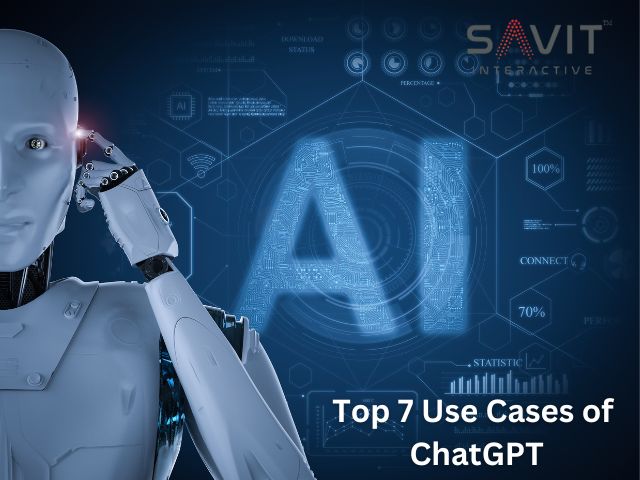74% of businesses want to use conversational Artificial Intelligence (AI) solutions to improve productivity, according to Drift’s 2021 State of Conversational Marketing research. So, it is evident that everyday AI applications have become increasingly common in recent years due to their diverse range of applications, including customer service, language translation, and virtual assistants.
ChatGPT use cases are one such application that depends on artificial intelligence models’ capacity to comprehend and produce natural language. The newest use cases of AI chatbot is upending numerous businesses by making replies that resemble human reactions to user inputs. In this article, we will go in-depth about ChatGPT use cases applications in various industries. But first, let’s define ChatGPT and see how it uses recent advancements in AI.
Describe ChatGPT
ChatGPT use cases is an AI chatbot that uses Natural Language Processing (NLP) to comprehend user inquiries and provide natural, conversational responses. In November 2022, Open AI, a U.S.-based AI research center, released it as a free research prototype. The chatbot is driven by the machine learning (ML) model known as Generative Pretraining Transformer-3 and is one of the most advanced NLP models to date (GPT-3).
How Was ChatGPT Made?
At its core, ChatGPT is an extensive language model built on the Generative Pretraining Transformer-3 and 3.5 that was established and developed utilising the following three mechanisms:
Step one: Extensive Pretraining
Pretraining refers to a database of text or words that the chatbot already has, enabling it better to comprehend the patterns and structure of natural language. As a result, since the AI use cases tool reacts to the context of the question, the results are conversational.
Step two: Transformer architecture
To efficiently analyse lengthy data sequences, the transformer structure comprises layers that may prioritise the words and phrases in user inputs. To give consumers more logical replies, the model then makes an effort better to comprehend the context and meaning of the information.
Moreover, the architecture’s feed-forward layers and residual connections help the tool comprehend complicated linguistic patterns, improving its ability to record different words and sentences.
Step three: Human Feedback for Reinforcement Learning (RLHF)
Since its creation, the chatbot has continually developed and taught itself using reinforcement learning from user input (RLHF). To communicate with the model, Open AI has employed human AI trainers that can play the parts of a user and a chatbot. To promote human-like conversational methods, trainers assess the quality of responses and compare the tone and correctness of the answers provided by ChatGPT use cases to human replies.
Top ChatGPT Usage
Many applications for ChatGPT exist in numerous sectors. It may be used, for example, to provide customised, automated replies to consumer enquiries in e-commerce, to produce high-quality content for email or social media marketing, and to instruct and teach students on various topics in e-learning. To aid data aficionados in better understanding the most recent AI tool, we will expand on the most extraordinary ChatGPT use cases in this area.
1. The ability to understand and respond to different linguistic sources
Users may leverage ChatGPT’s capacity to understand and react to diverse language inputs and obtain simple, uncomplicated answers to inquiries instead of using a search engine like Google or Bing. Getting a concise summary of important information is made more accessible since the AI use cases chatbot can explain complicated subjects in various tonalities or speaking styles.
2. The capacity to develop throughout time
One of ChatGPT’s main features is its capacity to learn from its interactions with users. It may modify and enhance its reactions when interacting with humans, gradually becoming more precise and organic. The variety of use cases that ChatGPT can support, thanks to its adaptability, makes it a potent instrument for further development and optimisation of future everyday use cases of AI systems.
3. Respond to inquiries
Several businesses are eager to integrate the ChatGPT AI-powered tool into their workflow to offer quick and knowledgeable solutions to frequent client inquiries and improve customer experience. By searching the Internet for certain user requests and concisely summarising important facts, AI chatbot use cases help organisations rapidly discover and address customer problem issues.
4. Better Interpretability
When more users supply information, the chatbot’s interpretation skills will advance thanks to reinforcement learning processes via human feedback. As a result, ChatGPT’s response quality will increase over time to more effectively suit user demands. The user experience will then be improved as a consequence.
5. Search Engines Other Than Google
An alternative to Google search is ChatGPT. Yet, it is arguable if ChatGPT use cases is a superior search engine to Google because it relies on the individual requirements and tastes of the user. It is the best option for people who prefer a conversational search experience over receiving links to websites as search results.
6. Employ AI to Create Effective Copy
Creating unique, creative, and engaging ad content for different marketing projects might be challenging. ChatGPT uses AI to produce compelling text, which facilitates the work of a digital marketer. The newest use cases of AI tools provide ad content concepts and structure to increase marketers’ efficiency significantly. Moreover, it can write persuading email text, boosting conversion rates for cold prospects.
7. To further education or training
How well ChatGPT can define words and sentences is fantastic. Yet when the chatbot’s skills advance and are honed over the ensuing years, it may alter how students connect with the outside world. Consequently, the education industry is among the most well-known ChatGPT use cases. Here, teachers may cover the fundamentals of a subject while giving students a place to ask questions and get any doubts cleared up.
Important Lessons from ChatGPT
- Large language models based on GPT3 and GPT 3.5 are used in ChatGPT, a potent AI tool.
- It uses machine learning algorithms on a vast corpus of literature to react to user requests in remarkably human-sounding words and phrases.
- It is designed to participate in honest and diverse discussions with people using the most recent advancements in AI technology, including transformer architecture, extensive retraining, and reinforcement learning.
- It may be used in various use cases across several industries, including retail, education, and marketing, because of its capacity to adapt to varied contexts and scenarios.








































